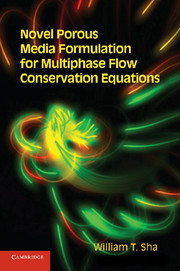Book contents
- Frontmatter
- Contents
- Figures and Table
- Foreword
- Foreword
- Foreword
- Nomenclature
- Preface
- Acknowledgments
- 1 Introduction
- 2 Averaging relations
- 3 Phasic conservation equations and interfacial balance equations
- 4 Local volume-averaged conservation equations and interfacial balance equations
- 5 Time averaging of local volume-averaged conservation equations or time-volume-averaged conservation equations and interfacial balance equations
- 6 Time averaging in relation to local volume averaging and time-volume averaging versus volume-time averaging
- 7 Novel porous media formulation for single phase and single phase with multicomponent applications
- 8 Discussion and concluding remarks
- Appendix A
- Appendix B
- Appendix C
- Appendix D
- References
- Index
1 - Introduction
Published online by Cambridge University Press: 07 October 2011
- Frontmatter
- Contents
- Figures and Table
- Foreword
- Foreword
- Foreword
- Nomenclature
- Preface
- Acknowledgments
- 1 Introduction
- 2 Averaging relations
- 3 Phasic conservation equations and interfacial balance equations
- 4 Local volume-averaged conservation equations and interfacial balance equations
- 5 Time averaging of local volume-averaged conservation equations or time-volume-averaged conservation equations and interfacial balance equations
- 6 Time averaging in relation to local volume averaging and time-volume averaging versus volume-time averaging
- 7 Novel porous media formulation for single phase and single phase with multicomponent applications
- 8 Discussion and concluding remarks
- Appendix A
- Appendix B
- Appendix C
- Appendix D
- References
- Index
Summary
Many years ago, a generic, three-dimensional, time-dependent COMMIX computer program based on the novel porous media formulation for single phase with multicomponent (see ) was developed. The computer program was then adopted throughout the world, and the novel porous media formulation has proven both promising and cost effective for many engineering applications. This book now presents the novel porous media formulation for multiphase flow conservation equations.
Multiphase flows consist of interacting phases that are dispersed randomly in space and in time. It is extremely difficult, if not impossible, to track down the interfaces between dispersed phases of multiphase flows. Turbulent, dispersed, multiphase flows can only be described statistically or in terms of averages, a fact that was not recognized during the early development of multiphase flow. Averaging procedures are necessary to avoid solving a deterministic multiboundary value problem with the positions of interfaces being a priori unknown. Additional complications arise from the fact that the flow system of interest often contains stationary and complex, solid, heat-generating and heat-absorbing structures. Although, in principle, the intraphase conservation equations for mass, momentum, and energy, as well as their associated initial and boundary conditions, can be written, the problem is far too complicated to permit detailed solutions. In fact, they are seldom needed in engineering applications. A more realistic approach is to express the essential dynamics and thermodynamics of such a system in terms of local volume-averaged quantities. This may be achieved by applying an averaging process, such as time, volume, or statistical averaging. The present work begins with local volume averaging, followed by time averaging. The whole process is called time-local volume averaging, or time-volume averaging.
Information
- Type
- Chapter
- Information
- Publisher: Cambridge University PressPrint publication year: 2011
